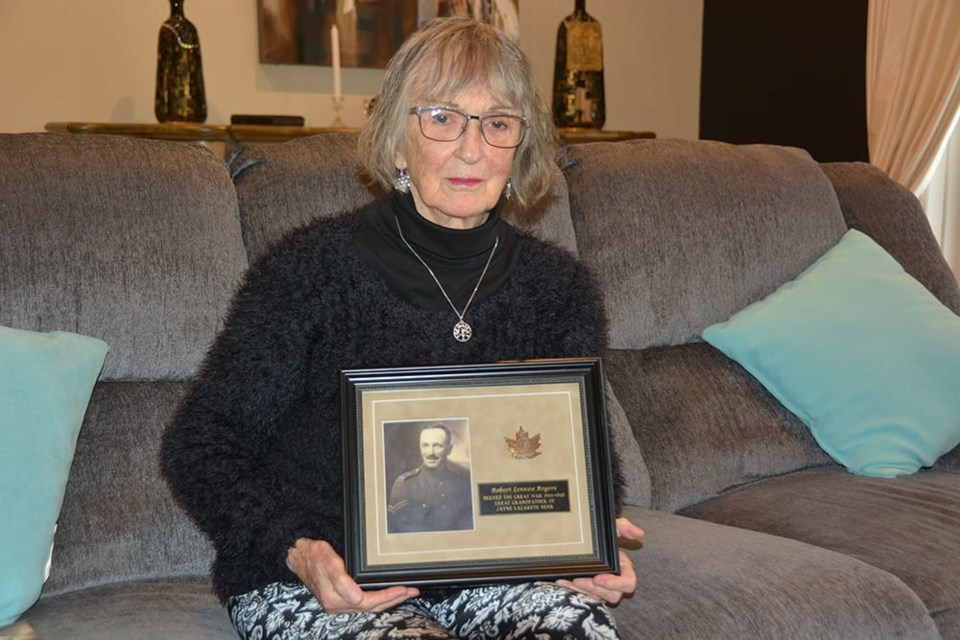Remembrance Day a solemn occasion for Shirley Lazareth
Shirley Lazareth’s family of patriots paid a heavy price in the cause of freedom.
Most vivid in her mind every November, as Remembrance Day approaches, are the two cousins who paid the supreme sacrifice. Both were WWII bomber pilots, killed over Europe. Len Rogers was 21. His brother Frank was only 19. The names of both men are on a plaque at the Runnymede Memorial, in Surrey, England.
Frank’s plane was lost during a night training mission on April 12, 1943. He and his crewmates were laid to rest in the Dishforth Cemetery in North Yorkshire, England.
Len’s four-engine heavy bomber, a Hadley Page Halifax carrying a crew of eight, fell victim to a Lufwaffe night fighter at 3 AM on August 3, 1943, and crashed in the North Sea off the coast of the Netherlands. His plane, assigned to the 428 “Ghost” Squadron, had been part of a large-scale attack on industrial targets in Hamburg, Germany. The entire crew perished, and most bodies were not recovered.
The Royal Air Force’s Bomber Command, composed of men from Britain, Canada, Australia, and New Zealand, hit targets in Germany relentlessly throughout the war in Europe, but at a heavy cost. Of a total of 125,000 aircrew, some 57,000 were killed (a 46 percent death rate). A further 8,400 were wounded in action and almost 10,000 became prisoners of war. It was the highest Allied casualty rate of any branch of service during the conflict.
The Rogers brothers were born on Quaker Road in Fonthill, and attended Port Colborne High School, where they were star athletes. When war broke out in 1939, Len had enlisted first, and became a flight instructor at Camp Borden, north of Toronto. When he learned that his younger brother was graduating from flight school in Aylmer, he hopped in a cockpit and flew to the ceremony, where he was given the honour of pinning the wings on Frank’s lapel. Len had just married Beverly Reeb, of Port Colborne, the weekend before he was shipped out to England for active duty.
Lazareth was 11 when her cousins were killed in action. Now in her late 80s, she reflects back on their heroism, and draws a parallel to the current-day pandemic.
“I think back to my relatives who were on the front lines in two world wars, doing their duty. And I think of all those who are fighting a battle today, as frontline workers in the war against COVID-19. We must each do our part…we too must sacrifice for the common good. It’s our duty.”
Robert Lennox Rogers, Lazareth’s grandfather, emigrated to Canada from England in 1913 with his family and settled in Pelham. He operated Rogers’ General Store at the corner of Pelham Street and Highway 20, which much later became the site of Keith’s Restaurant. At the outbreak of World War I, a sense of patriotism motivated him to return to Europe. He enlisted with his two sons, Bert and Edward (the latter the future father of Len and Frank). Edward was only 15 and too young for military service, but he used the birth certificate of a deceased older brother to qualify. Robert, Bert, and Edward all made it through the Great War unscathed.
Lazareth’s uncle, Arthur Martell Rogers, took part in the ill-fated 1943 Dieppe raid, in which he was wounded, captured, and held as a prisoner of war in Germany until 1945.
Her father would have served in WWII as well, but an injury suffered during an industrial accident left him “4-F” (unfit for combat).
“Dad had to stay home and look after all the women in the family. He kept all of us going.”
An interesting development has brought her cousin Len’s life and death back into focus for Lazareth.
An archivist at the Port Colborne Museum contacted her months ago, explaining that historical researchers in the Netherlands had identified five Allied flyers who, based on their “dog tags” (identification discs worn by all servicemen) may lie in the unmarked grave of an unknown airman in Holland, buried by Dutch citizens some 77 years ago, when his body washed ashore in November 1943. One of the possibilities is Len Rogers.
Willem de Jong, a lead researcher with the investigation, has been in contact with Lazareth numerous times via email, sending her information and photos about Len’s plane and its crew. De Jong and his team of volunteer historians have won her admiration.
“It's just absolutely amazing how the Dutch people have perpetuating the memory of all of these lost airman. Whether they were Allies or German, it didn’t matter. The Dutch respected the sacrifice, and buried them all with reverence.”
The only way to know for sure the identity of the airman in Grave #68 in Holland is to exhume the body and test it for DNA, to see if it matches the genetic code of surviving family members. Lazareth is anxiously awaiting further developments.
The local branch of the Royal Canadian Legion has also earned a warm spot in Lazareth’s heart of late.
“They have been good to me this year. I had colon cancer surgery in January, and twice a week during the winter, they brought food to our house,” she said.
But Shirley has grown despondent over the behavior of some young people, who disregard COVID health and safety edicts about wearing a mask and limiting social mingling.
“This is so important. I don’t know how we get through to these young people,” she said. “I've tried speaking to them…telling them about my cousins’ sacrifice, going off to war so young. But many just aren't listening.”



